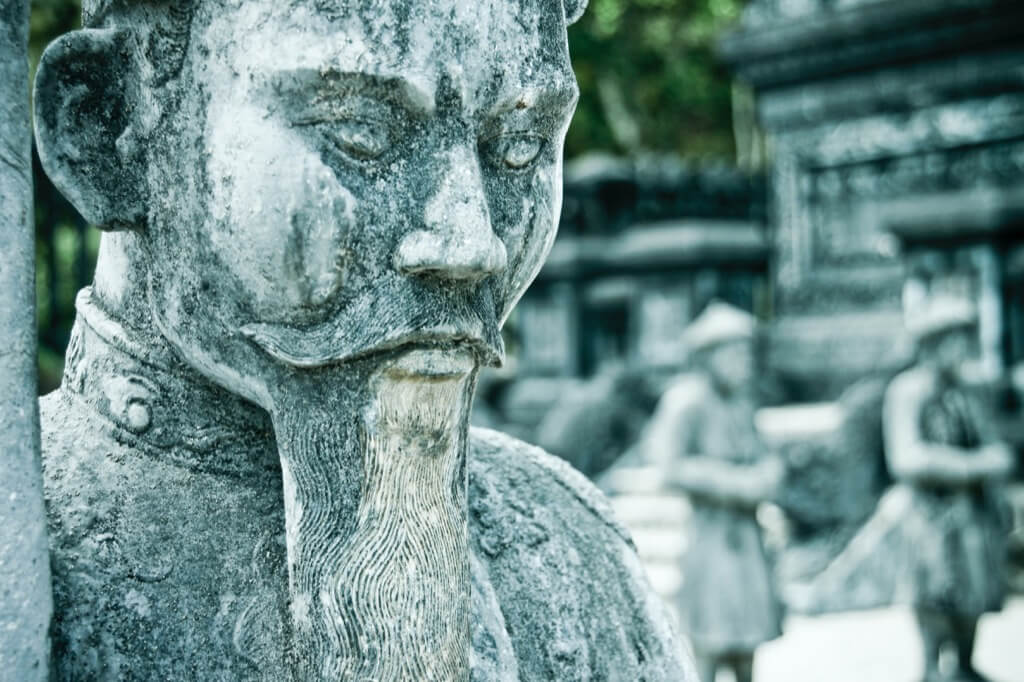In the late 15th century, Amerigo Vespucci embarked on voyages to the New World, distinct…
Tiahuanaco’s Hidden Legacy
- by Mamparra

Deep in the heart of the Andes Mountains, along the shores of Lake Titicaca in modern-day Bolivia and Peru, an advanced civilization once thrived. Tiahuanaco, a magnificent metropolis, emerged and prospered for nearly 500 years before vanishing into history. Today, we delve into the mysterious world of Tiahuanaco, exploring its origins, achievements, and enigmatic disappearance.
Tiahuanaco’s rise is believed to have occurred around 300 AD, with its zenith spanning from 500 to 900 AD. Situated at an astonishing elevation of over 12,500 feet, the region boasted favorable conditions, including abundant wildlife, fertile land, and pastures, capable of sustaining a substantial population.
Ingenious agricultural techniques played a pivotal role in their success. Tiahuanacoans engineered raised fields encircled by intricate water canals known as “suka kollus.” These canals not only provided irrigation but also absorbed solar heat during the day, releasing it at night to safeguard crops from frost. This innovation was crucial for survival in the harsh Andean climate.
On a cultural level, Tiahuanaco shared similarities with other great South American civilizations. Its influence extended through a combination of military might and trade, establishing dominance in regions of Argentina, Chile, Peru, and Bolivia by 700 AD. At its zenith, Tiahuanaco was a colossal city-state, with population estimates ranging from 285,000 to 1.5 million.
Within the city, awe-inspiring structures rose, constructed from massive stones meticulously cut and fastened with robust metal I-clamps. Elaborate decorative elements were carved from green andesite rock, showcasing their artistic prowess.
The intriguing aspect of Tiahuanaco’s construction lies in the transportation of colossal stone blocks, some weighing up to 140 tons, from a quarry six miles away. Even more astonishing, the green andesite stones used for special structures originated from a site over fifty miles away, across Lake Titicaca. The methods employed for such transportation remain a mystery, fueling numerous hypotheses.
Tiahuanaco boasts several remarkable structures, including platforms like Akapana, Puma Punku, and Akapana East, three courtyards (Putuni, Kheri Kala, and Kalasasaya), various gates, notably the famed Gateway of the Sun, and an underground temple adorned with intricate carvings.
Many experts believe that Tiahuanaco’s power stemmed from its innovative agricultural practices. However, the civilization’s ability to sustain itself was severely challenged by a devastating drought triggered by climate change around 950 AD. Within half a century, the once-mighty metropolis was deserted, leaving behind a haunting enigma.

In the realm of neuroscience, few mysteries have captivated scientists and the general public alike…

In the dimly lit trenches of World War I, where every move could mean life…
Legends and Folklore
While archaeological evidence offers valuable insights, it remains insufficient to trace the specific origins of Tiahuanaco’s builders or the fate of its highly civilized inhabitants. Historians studying this ancient civilization have turned to the folklore of neighboring societies, passed down through generations via oral tradition, in a quest to distinguish myths from historical truths.
The precision with which Tiahuanaco’s structures align with celestial events is a testament to the civilization’s profound astronomical knowledge. Among the most remarkable examples is the “Gateway of the Sun,” a monolithic archway that aligns perfectly with the winter solstice sunrise. This alignment isn’t an isolated instance; many other structures in Tiahuanaco exhibit similar precision, suggesting that their architects possessed a deep understanding of solar and lunar cycles. This cosmic connection likely played a significant role in their culture and rituals, with celestial events guiding their agricultural and religious practices.
Tiahuanaco’s megalithic stonework continues to baffle researchers. The builders achieved an astonishing level of precision in their stone carving, crafting massive stones that fit together seamlessly, often without the use of mortar. What’s more intriguing is the presence of curious indentations and carvings on these stones. Some believe these markings may hold encoded information or have ritualistic significance. These unexplained stonework details remain an enigma, fueling speculation about their purpose and meaning.
Architectural Marvels or Connectors?
Puma Punku, a complex within Tiahuanaco, features massive H-shaped stone blocks, some weighing over 100 tons. These H-blocks stand as one of the most perplexing elements of Tiahuanaco’s architecture. While their exact purpose remains unclear, they are thought to have served as connectors in the city’s intricate construction. Some theories suggest that these H-blocks played a role in stabilizing walls or acted as part of an elaborate irrigation system. Their mystery endures as researchers seek to unravel their true function.
Unlike many ancient civilizations, Tiahuanaco left behind no written records or inscriptions. This absence of a written language poses a unique challenge for researchers attempting to decipher their history and culture. Instead of words, Tiahuanacoans communicated through other means, such as intricate stone carvings and symbolic art. The lack of a written language adds an extra layer of mystique to this ancient civilization, leaving us to rely on non-verbal clues to unlock its secrets.
Masters of Craftsmanship
The precision and craftsmanship displayed in Tiahuanaco’s stone carving are nothing short of astonishing. The “Frog of Tiwanaku” sculpture is a prime example of their artistic prowess. This intricate piece showcases their ability to carve stone with intricate detailing and lifelike accuracy. Such precision hints at a highly developed culture that valued artistry and aesthetics, leaving behind a legacy of exceptional stone craftsmanship that continues to captivate modern observers.
Gigantic Underground Pyramid
Beneath the Akapana pyramid lies a vast network of underground chambers and tunnels, a subterranean labyrinth that remains shrouded in mystery. These underground structures, largely unexplored, raise questions about their purpose and function. Some speculate they were used for storage, rituals, or even as a refuge during inclement weather. The true significance of these underground passages remains speculative, adding an intriguing layer to Tiahuanaco’s architectural complexity.
Tiahuanacoans were accomplished potters, creating finely crafted ceramics adorned with intricate motifs and vibrant colors. These ceramics provide valuable insights into their artistic expression and cultural practices. The pottery showcases their ability to blend aesthetics with functionality, with vessels designed for everyday use as well as ceremonial purposes. Through these artifacts, we gain a glimpse into the rich tapestry of Tiahuanacoan culture.
The civilization’s mastery extended beyond stone carving to include sophisticated irrigation systems. They engineered intricate canal networks to manage water flow, showcasing their advanced understanding of hydraulics. These systems served not only for agriculture but also as a testament to their engineering prowess. The ability to harness and distribute water efficiently played a crucial role in sustaining their civilization on the high plains of the Andes.
Legends of Viracocha
Tiahuanaco’s origin is shrouded in myth and legend. According to some indigenous communities, the city was founded by the god Viracocha, a figure of great significance in Andean mythology. This mythical origin adds a layer of mysticism to Tiahuanaco’s history, intertwining it with divine narratives. These legends have been passed down through generations, connecting the ancient civilization to the spiritual beliefs of the Andean peoples.
Some researchers propose that Tiahuanaco’s monumental structures, including the Gateway of the Sun, served as a calendar system. These structures marked important astronomical events and agricultural cycles. The civilization’s deep understanding of celestial movements allowed them to align their architecture with cosmic events, integrating their daily lives with the cosmos. This theory underscores the sophistication of Tiahuanaco’s culture and their harmonious relationship with the natural world.
In the heart of the Andes, a civilization once thrived, leaving behind an indelible mark on the landscape and in our collective curiosity. Their celestial insights, enigmatic stonework, and mysterious H-blocks speak of a culture deeply attuned to the cosmos. Yet, the absence of written records challenges our efforts to fully embrace their narrative. As we marvel at the precision of their craftsmanship and the mysteries of their underground world, we are reminded that the echoes of ancient civilizations continue to resonate in the corridors of time. Tiahuanaco beckons us to explore, question, and appreciate the rich tapestry of human history that stretches beyond the boundaries of memory.
Deep in the heart of the Andes Mountains, along the shores of Lake Titicaca in modern-day Bolivia and Peru, an advanced civilization once thrived. Tiahuanaco, a magnificent metropolis, emerged and prospered for nearly 500 years before vanishing into history. Today, we delve into the mysterious world of Tiahuanaco, exploring its origins, achievements, and enigmatic disappearance.…
Recent Mamparras
- Zwai Bala – The Musical Pioneer Who Helped Shape South Africa’s Sound
- Is This the Worst Own Goal Ever? Watch and Decide
- Mamparras Spend R7.7 Billion From 25th to the 31st of December 2024
- Why Do Liberals Think Trump Supporters Are Mamparas?
- Indepth Look at the Online Thrill to Grill Casino Game
- Artist Discovers 2000yo Roman Bust at Texas Goodwill for $34
- Nobuntu (Mamparra-nobs) Mkhize Disrupts FlySafair Flight – Gets Arrested
- Oscar Pistorius Walks Free, But Where is Reeva’s Justice?
- The Accidental Aboriginal’s Legacy
- The Origins of Oktoberfest
- Fascinating Quick Facts

